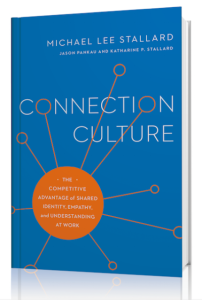Connection is a hot leadership topic for me this month. I’ve been exploring the impact of connection on how and why work gets done. There is a strong link between effective connection and results. In my work with leaders and teams, I have observed a range of cultures in which connection is present; I have also seen the opportunity for connection to be deepened and instilled as a cultural priority.
We know that effective leadership requires the presence of two key dimensions; the relational (how we work with and through others) and task (the getting things done part). Decades ago, leadership placed a heavy emphasis on “task” orientation, with “getting things done” taking priority over the relationships. Connection was valued far less than producing a specific result. This paradigm is a relic of the past, and simply won’t work in the complex, inter-connected environment in which leaders must operate today.
This year we’ve been engaged with multiple clients in a series of Leadership 360 assessments. This work underscores the importance (and delicacy) for leaders in balancing these two dimensions. In the assessment process, we come to see that the importance of relational skills cannot be overemphasized. Connection comes through relationships. Yet when things get super-busy, the scale tips more towards “task” orientation. Relationships begin to take second-place. Leadership effectiveness suffers.
[notification type=”alert-info” close=”false” ]
Connection Dysfunction
[/notification]
Have you noticed any of these tell-tale signs of connection-dysfunction?
- Emails become the dominant form of communication, instead of phone and in-person conversations
- Decision-making becomes reactive; getting something done—anything—instead of having conversations to explore alternatives
- Reliance on ticking things off the list instead of scheduling time to brainstorm about what’s possible?
 Leading Blog notes that Michael Lee Stallard in his new book, Connection Culture finds a range of connection cultures in most organizations, from cultures of control to cultures of indifference.
Leading Blog notes that Michael Lee Stallard in his new book, Connection Culture finds a range of connection cultures in most organizations, from cultures of control to cultures of indifference.
Most leaders are not intentional about developing connection and connection cultures. Creating connection cultures should be an organization’s highest priority because:
- Employees who feel connected perform at the top of their game. They are more energetic, optimistic, make better decisions, are more creative and live longer.
- Employees who feel connected give their best effort. They go above and beyond because they care about the community they are a part of.
- Employees who feel connected align their behavior with organizational goals. Research has shown that nearly one in five employees works against his or her organization’s interests. Organizations with a connection culture experience a higher percentage of people who pull in the same direction.
- Employees who feel connected help improve the quality of decisions. Employees who care are more likely to speak up and share information even if they think the decision makers would rather not hear it.
- Employees who feel connected actively contribute to innovation. Connected employees actively look for ways to improve the organization and contribute to its marketplace of ideas.
[notification type=”alert-success” close=”false” ]
Questions to consider:
[/notification]
[icon type=”glyphicon glyphicon-question-sign” color=”#81d742″ fontsize=”24″] Are you intentional about connecting in your culture?
[icon type=”glyphicon glyphicon-question-sign” color=”#81d742″ fontsize=”24″] What is the way we most frequently connect?
[icon type=”glyphicon glyphicon-question-sign” color=”#81d742″ fontsize=”24″] What are the qualities of our connections?
I have discovered that one of the best ways to increase connection is through a facilitated workshop, in which a team works collaboratively on mission, vision, and values. Participants become energized through exercises and questions that help them get out of their “day-to-day” habits. They discover (and uncover) much that hasn’t been previously shared. A more cohesive team unfolds. Connection is happening.
Creating a connecting culture is an important part of leading effectively. Let’s connect!
Please post your comments here. To explore how connected you are, take my free Leadership Effectiveness Quotient quiz.


